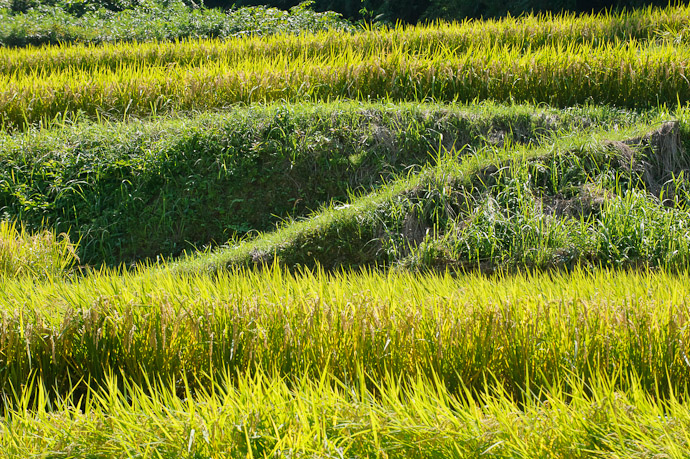
Nikon D700 + Nikkor 70-200mm f/2.8 @ 140mm — 1/800 sec, f/13, ISO 2500 — map & image data — nearby photos
Gradations
five rice paddies in the mountains of north-eastern Osaka Prefecture, Japan
In yesterday's post I talked about the highlight of a recent scooter trip into the mountains of rural Nara Prefecture, meeting a friendly farmer lady. Prior to meeting her, the highlight was enjoying the scenes of rice harvest, so today's post is few shots from various places prior to meeting her. Most are from the very rural edge of Katano City, Osaka Prefecture, just prior to crossing over the pass to the equally rural edge of Ikoma City, Nara Prefecture. As always, the photos have map links under them.
In the photo above, I was going for the same vibe as in these photos from a couple of years ago, but the result is, unfortunately, just too bright and monochromatic to grab my attention. Oh well.
You can see the same area from a different angle in the next shot....
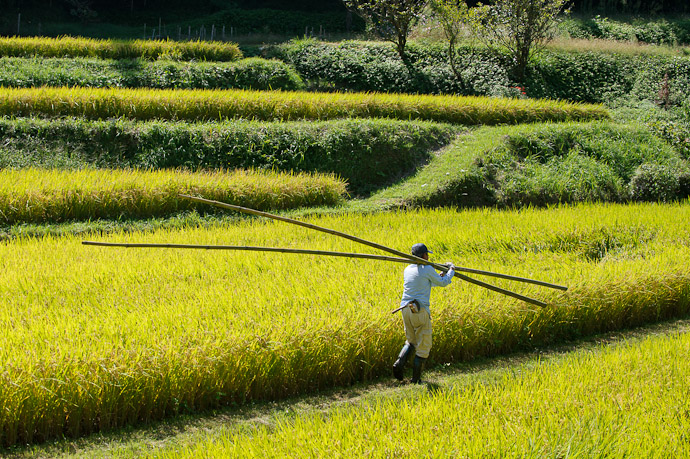
Nikon D700 + Nikkor 70-200mm f/2.8 @ 70mm — 1/800 sec, f/4.5, ISO 200 — map & image data — nearby photos
Atlas
The long bamboo poles he's carrying are used in the rice harvest, as we'll see in a bit. In the shot above, he's walking toward his house, which you can see better in the next photo...
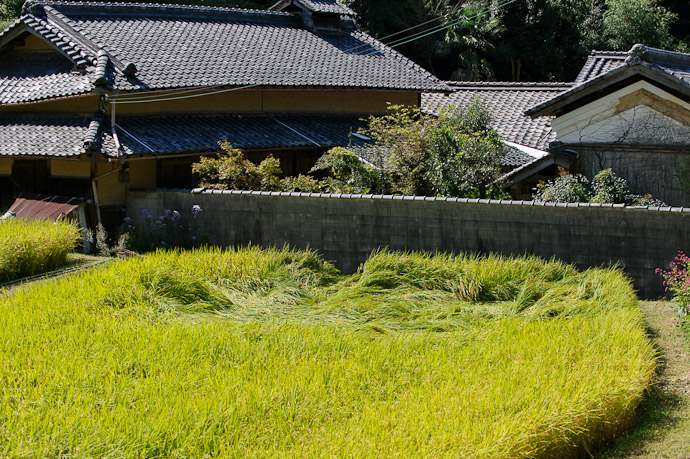
Nikon D700 + Nikkor 70-200mm f/2.8 @ 80mm — 1/800 sec, f/5, ISO 220 — map & image data — nearby photos
Violent Wind Damage
An isolated section of rice was smooshed flat for no apparent reason, but I asked a farmer and he explained that it was the wind, like a small tornado...
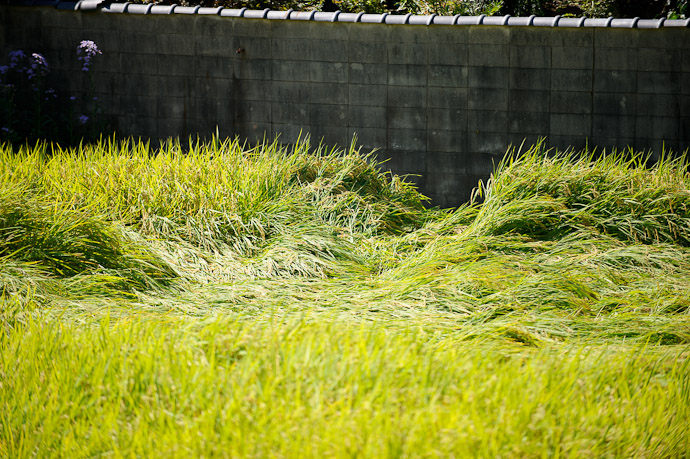
Nikon D700 + Nikkor 70-200mm f/2.8 @ 200mm — 1/1600 sec, f/2.8, ISO 200 — map & image data — nearby photos
“From a Small Tornado”
so I'm told
One sees this kind of damage from time to time. I'm not sure I buy the tornado theory due to the lack of circularness in the smooshed-rice pattern, but I do believe that a violent downdraft, say of wind raging down the mountain during a typhoon, could be forcefully enough to snap the stalks. This rice, I was told, will likely be salvagable because it wasn't pushed under water. I don't know when the damage occurred, but a couple of typhoons that swept through the area at times this month are likely culprits. At the moment, all the fields are drained of water in preparation for harvest.
There's a road-side vending machine next to the house, which seems to function like a small convenience store for folks in these parts. The farmer I chatted with had walked up from his field further down the mountain to get a drink. We had a nice chat.

Nikon D700 + Voigtländer 125mm f/2.5 — 1/3200 sec, f/2.5, ISO 200 — map & image data — nearby photos
Gentleman Farmer
Just to offer a bit of perspective on the location, here's a view of the house and rice paddies from a bit up the road, looking out toward Katano City in northern Osaka Prefecture....
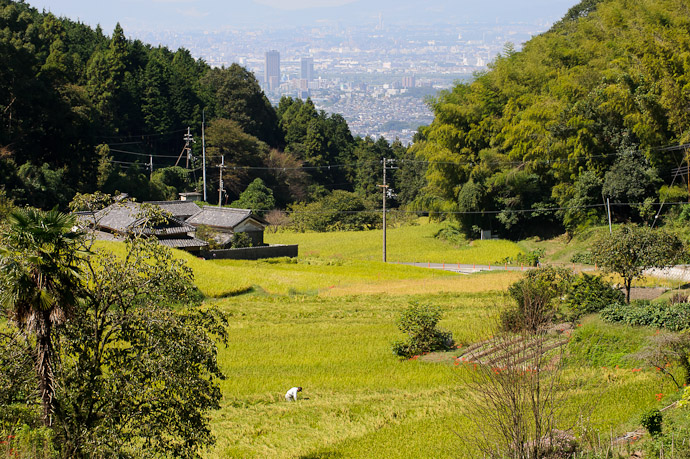
Nikon D700 + Nikkor 70-200mm f/2.8 @ 125mm — 1/800 sec, f/11, ISO 1250 — map & image data — nearby photos
Perspective
The tall buildings in the foreground of the background are about 8km away, here. The tall building in the haze in the far background is about 20km away, here.
To the right of the farmer in the photo above, you can see some red flowers at the edge of the rice fields. They were growing in bunches in random spots here and there...
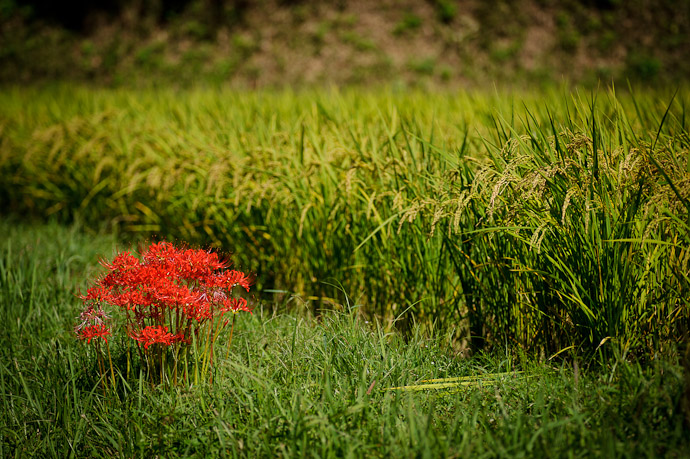
Nikon D700 + Voigtländer 125mm f/2.5 — 1/2500 sec, f/2.5, ISO 200 — map & image data — nearby photos
Red Spider Lily
They made for a nice spot of color against all the green. I had no idea what they were, but looked them up to find that they're red spider lilys, in Japanese, higanbana (彼岸花) literally “equinox flower”. Wikipedia tells me that because the bulbs are poisonous, they're often planted near rice fields to deter pests like mice.
Here's a closer view of a bunch that I came across later, near the side of the road.
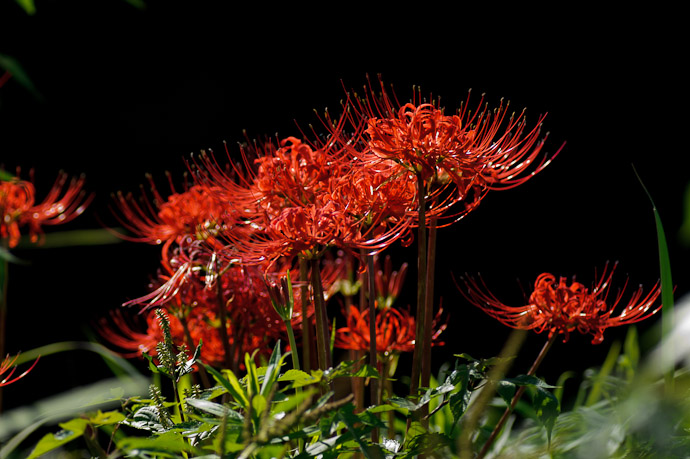
Nikon D700 + Voigtländer 125mm f/2.5 — 1/1250 sec, f/2.5, ISO 200 — map & image data — nearby photos
Once the rice is ready to harvest, as all this rice is, they'll cut it off just above the ground...

Nikon D700 + Nikkor 70-200mm f/2.8 @ 82mm — 1/500 sec, f/4, ISO 220 — map & image data — nearby photos
Ready
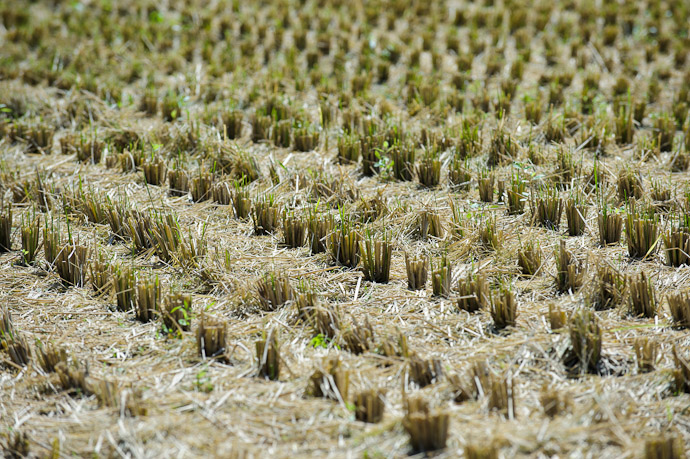
Nikon D700 + Nikkor 70-200mm f/2.8 @ 200mm — 1/800 sec, f/5.6, ISO 200 — map & image data — nearby photos
Stubble
The lowest paddy on the mountain had already been cut, but the rice not yet bundled and hung to dry...
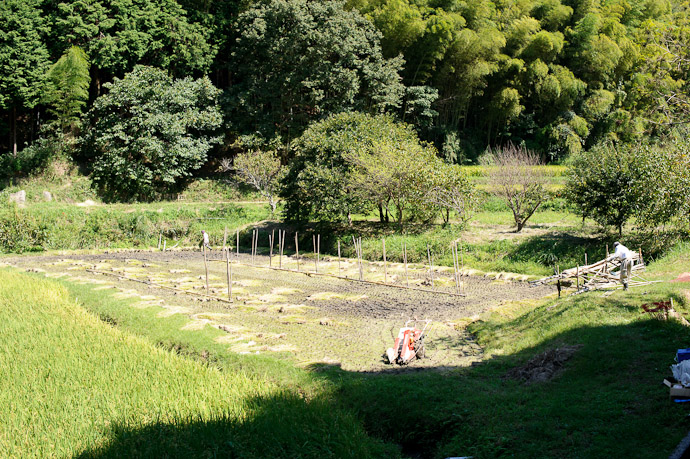
Nikon D700 + Nikkor 50mm f/1.4 — 1/800 sec, f/5, ISO 250 — map & image data — nearby photos
During Harvest
The bamboo poles sticking in the ground are the beginning of a framework for hanging the rice bundles to dry. You can see the farmer at the right side of the photo with a stack of bamboo, as who I suppose is his wife in the background working on making bundles...

Nikon D700 + Nikkor 70-200mm f/2.8 @ 200mm — 1/2500 sec, f/2.8, ISO 200 — map & image data — nearby photos
Under Construction
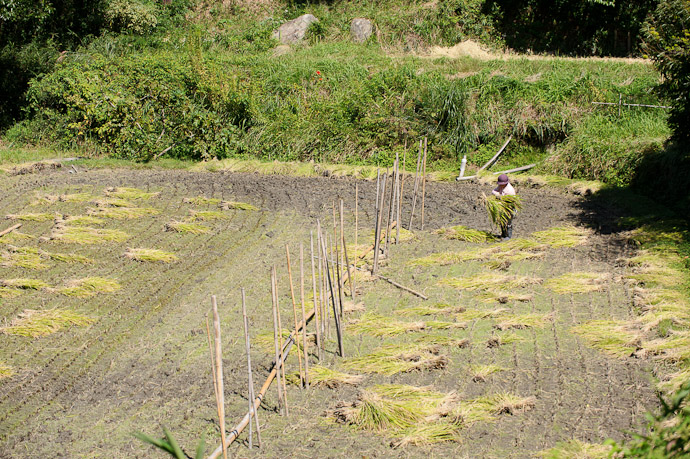
Nikon D700 + Nikkor 70-200mm f/2.8 @ 102mm — 1/800 sec, f/5.6, ISO 320 — map & image data — nearby photos
Bundling
Moving over the mountain pass into Nara, near the lady I chatted with yesterday, I came across some areas with cut rice hanging to dry...
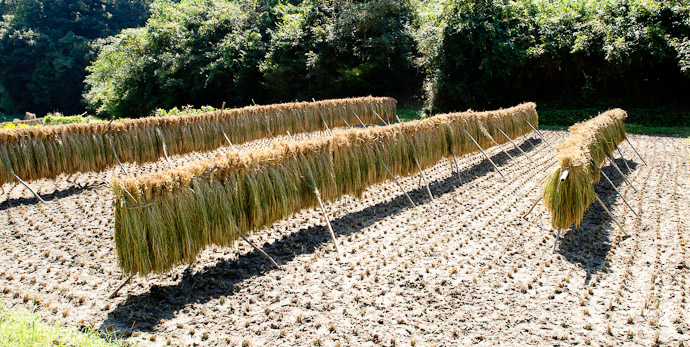
Nikon D700 + Nikkor 24mm f/1.4 — 1/250 sec, f/10, ISO 560 — map & image data — nearby photos
Drying Out
The combination of hills, rice paddies in various stages, vegetable fields, etc., made for some nice scenes...
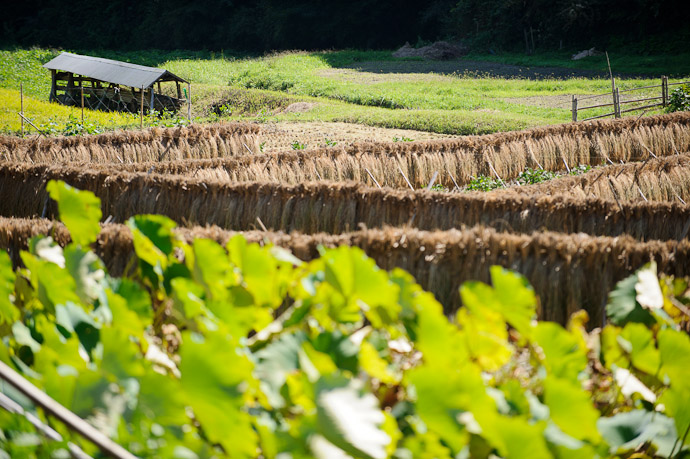
Nikon D700 + Nikkor 70-200mm f/2.8 @ 200mm — 1/1250 sec, f/3.2, ISO 200 — map & image data — nearby photos
Quintessential Farming Vista
The next sequence shows an ever-closer look at the rice...
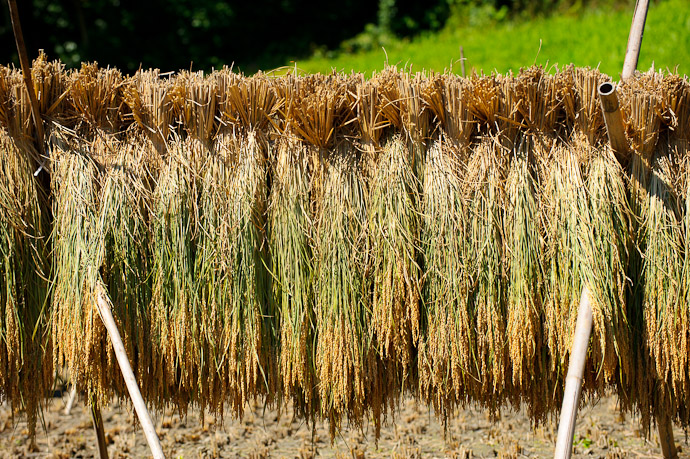
Nikon D700 + Nikkor 70-200mm f/2.8 @ 125mm — 1/800 sec, f/5, ISO 200 — map & image data — nearby photos
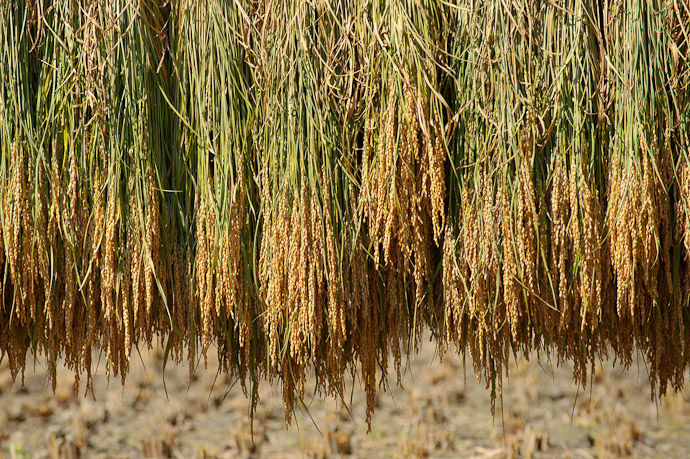
Nikon D700 + Nikkor 70-200mm f/2.8 @ 200mm — 1/500 sec, f/5, ISO 200 — map & image data — nearby photos
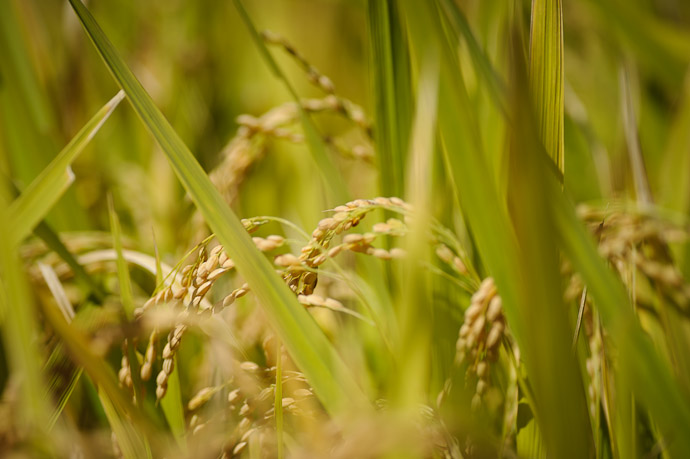
Nikon D700 + Voigtländer 125mm f/2.5 — 1/5000 sec, f/2.5, ISO 200 — map & image data — nearby photos
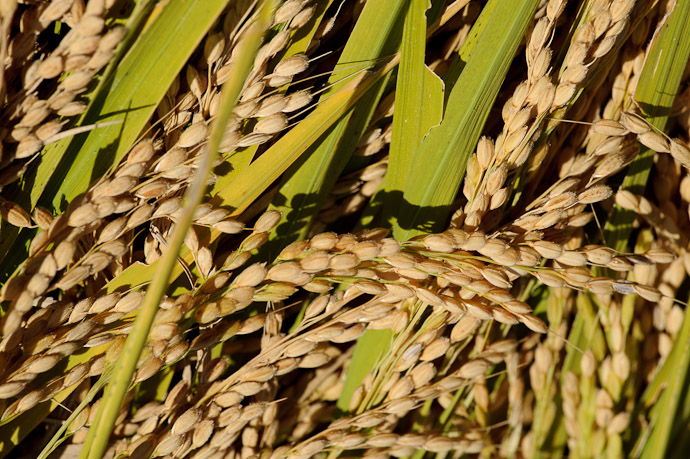
Nikon D700 + Voigtländer 125mm f/2.5 — 1/1000 sec, f/5.6, ISO 200 — map & image data — nearby photos
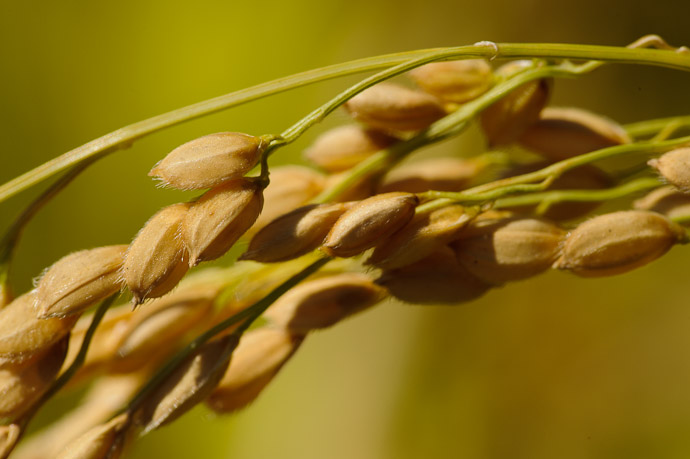
Nikon D700 + Voigtländer 125mm f/2.5 — 1/500 sec, f/5.6, ISO 280 — map & image data — nearby photos
Rice
Up Close and Personal
Here's a full-resolution crop from that last shot, to show some detail in the rice husk. (It was a handheld shot while crouched down at the edge of a rice paddy, with the wind blowing, while half concentrating on listening to the farmer lady tell her husband about me somewhere off in the distance.... so please excuse the lack of sharpness.)
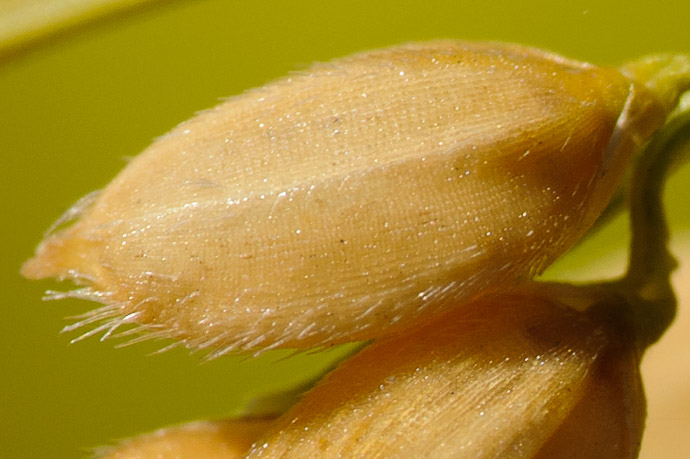
Husk
full-resolution crop from above
I'll post more from this trip later, but for reference I posted this kind of thing four years ago, in “The Rice Harvest” and “The Rice Harvest, Old-School”. And for the flip side, there's “Preparing a Paddy for Rice Seedlings”.
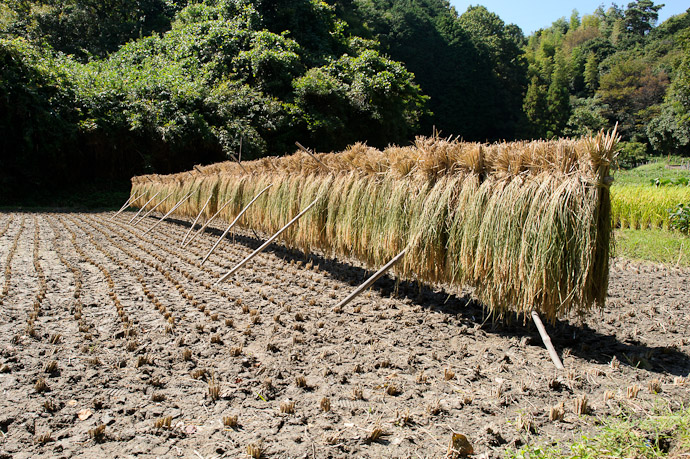
Dear Jeffrey,
Am a short-term visitor in Japan and made some pictures somewhat like yours in the last couple of weekends: spider lilies (thanks for giving the name!), rice harvested & drying. But I see I still have to learn a lot about photography: your pictures are much nicer!
You’re getting rather Japanese in your diffidence: “so please excuse the lack of sharpness”. LOL, you know you’re joking!
Thanks for the continuing inspiration–I’ll keep trying!
Jeffrey, could you estimate the amount of rice grown around the place that is used to feed Kyoto? Is it exported to other parts of Japan?
I was wondering the same thing myself on the way home… once you leave the mountains in that area, there are large flat areas filled with rice paddies, and I wondered whether such bounty was enough to supply the town, a small percentage of what the town needed, or a large surplus. I truly have no idea. —Jeffrey
Really liked this tour of the harvest. V interesting. One thought, any photos of the field-draining mechanisms? Am sure they would not be very photogenic but if you got a couple that would satisfy the odd irrigation interests of your readers!?.
RE the spider lillies – perhaps Peter in Wales can advise but are these what we over here might call Nerines? Or Guernsey Lillies? They are a really tremendous red aren’t they!
Annie
I don’t think it answers parv’s question, but there are some interesting statistics and trends on this Japanese government website:
http://www.stat.go.jp/english/data/handbook/c05cont.htm#cha5_5
I do wonder what the yield of rice, in particular, would be from a small farm like this, what else they grow, and how they market their crops.
Annie, no these Japanese spider lilies are Lycoris radiata, but it is very similar and presumably closely related to the South African Nerine. Guernsey lily is Nerine sarniensis, which was in the 17th century mistakenly thought to be from Japan. Lycoris is said to be pretty frost-hardy, but there must be a reason why it is not grown in our UK gardens – I suspect it needs more reliable summer heat and perhaps drier winters. When I first became interested in Japan and its flowers, photographs in books of the red spider lilies intrigued me, looking so exotic, almost incongruous, among the other Japanese wild-flowers; but I never saw them in flower during my visits, so it’s great to see them here.
Hi Jeffrey,
Thanks as always for sharing your great photos. I’ve always been intrigued by the contrast between “modern,” industrial Japan and the timelessness of its rural areas. This post illustrates how very close the two come to each other. Fascinating!
ヒガンバナって英語でこう表現するんですね。知らなかった。勉強になりましたー
So THAT’s why you see those flat bits in rice fields! I’ve always wondered about that. Thanks for stunning photos (as always). PS: As a South African, I’m also happy to hear about the spider lily’s link with my home country. This post has taught me a lot!
First pictures remember me the landscapes photos of Atsushi Motoi.
Very nice shots.
Your gentleman farmer has either been to Australia, or been given his cap from someone who has been there. The first I suspect 🙂
A bit of trivia for parv. The place I was born and raised in Australia is in New South Wales (State) and the regional area is called the Riverina and there is an irrigation area called the Murrumbidgee Irrigation Area.( http://en.wikipedia.org/wiki/Murrumbidgee_Irrigation_Area) This irrigation area was built after WW2 and settled by returned soldiers. The MIA grows a great proportion of Australias Rice; Oranges; Grapes and produces some of the best wines in the world. How does this relate to parv’s question? We produce more rice than we could ever eat. In the early 90’s the MIA started to produce Rice for the Japanese market after the import bans were lifted by the Japanese Government. Sushi & Koshihikari Rice along with specialty rices grown for the Japanese Beer market. The majority of all rice grown in Australia is now exported to over 70 countries with Japan being one of our largest customers even though they produce a surplus of rice each year. The Japanese Rice industry has had an interesting history, but production and quality is starting to decline hence the increase of imports from other countries. You can find out more about the Japanese Rice Industry @ http://factsanddetails.com/japan.php?itemid=939&catid=24&subcatid=159#16